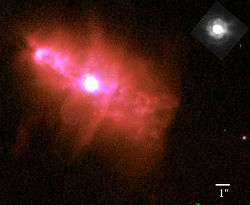IC 2149
| Nebula | |
|---|---|
|
Near-infrared image of IC 2149 | |
| Observation data: J2000.0 epoch | |
| Right ascension | 05h 56m 23.862s[1] |
| Declination | 46° 06′ 17.5″[1] |
| Distance | ~1100 ly |
| Apparent magnitude (V) | 10.6 |
| Apparent dimensions (V) | 12 |
| Constellation | Auriga |
| Designations | PK 166+10 1, HD 39659, PN G166.1+10.4, PN ARO 23, IRAS 05526+4605, 2MASX J05562386+4606175 |
IC 2149 is a planetary nebula in the constellation of Auriga. It is a small, bright planetary nebula with something to offer in telescopes of most sizes.[2]
Characteristics
Visually it has an apparent magnitude of 10.6 and an apparent size of 12 arc seconds and like other objects of its class a nebular filter may help on its observation.[2]
Its distance to the Solar System has been estimated to be around 1.1 kiloparsecs, having a total mass of 0.03 solar masses and being thought to have been produced by a low-mass star.[3]
Some authors have proposed the planetary nebula that our Sun will produce will be similar to this one, but smaller.[4]
References
- 1 2 "SIMBAD Astronomical Database". Results for IC 2149. Retrieved 2016-11-17.
- 1 2 http://observing.skyhound.com/archives/jan/IC_2149.html Skyhound
- ↑ Vázquez, R.; Miranda, L. F.; Torrelles, J. M.; Olguín, L.; Benítez, G.; Rodríguez, L. F.; López, J. A. (2002). "Multiwavelength Observations of the Peculiar Planetary Nebula IC 2149". The Astrophysical Journal. 576: 860–869. Bibcode:2002ApJ...576..860V. doi:10.1086/341792.
- ↑ Schröder, K.-P.; Connon Smith, Robert (2008). "Distant Future of the Earth and Sun revisited". Monthly Notices of the Royal Astronomical Society. 386: 155–163. arXiv:0801.4031
 . Bibcode:2008MNRAS.386..155S. doi:10.1111/j.1365-2966.2008.13022.x.
. Bibcode:2008MNRAS.386..155S. doi:10.1111/j.1365-2966.2008.13022.x.
This article is issued from Wikipedia - version of the 11/18/2016. The text is available under the Creative Commons Attribution/Share Alike but additional terms may apply for the media files.
